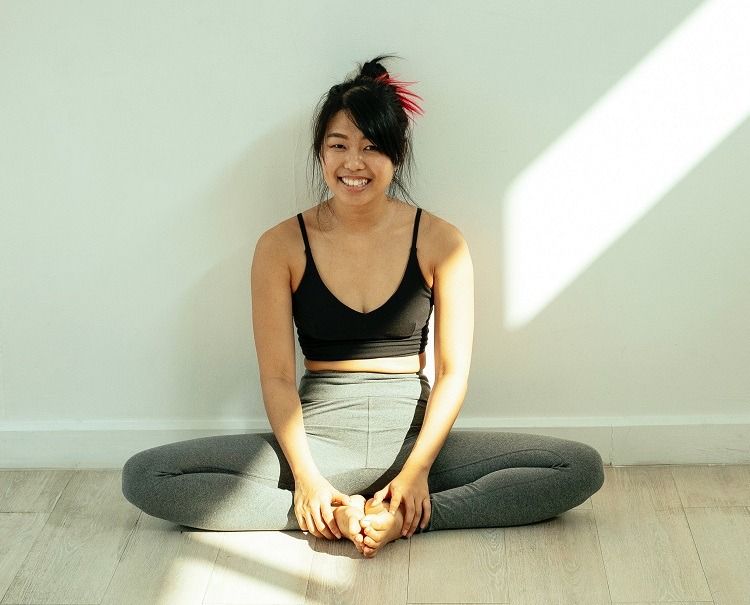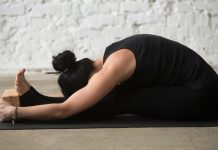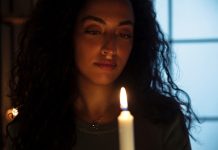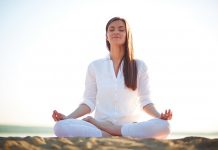
Baddha Konasana, also known as the Bound Angle Pose or Butterfly Pose. It is also called as Cobbler Pose as you settle into the original pose, the resemblance to a cobbler at work. Rooted in ancient traditions, this seated posture holds profound physical and mental benefits. Let’s explore its advantages, and learn how to incorporate it into your yoga routine.
The Meaning of Baddha Konasana:
Baddha Konasana derives its name from Sanskrit words: “Baddha” meaning bound, “Kona” signifying angle. The pose reflects the graceful fluttering of a butterfly’s wings, symbolizing the opening and release that it offers. In this asana, the practitioner sits with the soles of the feet drawn together, resembling an open book. This simple yet potent posture awakens the hips, stimulates the pelvis, and nurtures flexibility along with a sense of inner calm.
How to Perform Baddha Konasana:
1. Find Your Foundation:
Start by sitting on the mat with your legs extended in front of you. Take a deep breath and relax.
2. Draw Your Feet In:
Bend your knees and draw the soles of your feet together, allowing your knees to fall open.
3. Bind Your Feet:
Hold your feet with your hands, interlocking your fingers around your toes. Gently press your elbows against your thighs.
4. Lengthen Your Spine:
Inhale deeply and elongate your spine. Lift your chest and engage your core muscles.
5. Explore Your Edge:
As you exhale, gradually lower your knees towards the mat. Avoid forcing them down; instead, honor your body’s current level of flexibility.
6. Maintain Your Breath:
Breathe slowly and evenly as you settle into the pose. Feel the stretch in your inner thighs and groin area.
7. Hold and Release:
Hold the pose for several breaths, then release and return to the starting position.
Variations of Baddha Konasana
Let’s journey through the variations and explore the wealth they bring to your yoga experience.
Supta Baddha Konasana (Reclined Butterfly Pose):
Derived from “supta,” meaning supine or reclining, Supta Baddha Konasana or Reclined Butterfly Pose offers the comfort of reclining to this nurturing posture. Place a cushion or bolster along your spine or under your shoulders. Start in Butterfly Pose, then use your hands to lie down on your back. Lie on your back, soles of your feet still touching, allowing your knees to gently descend to the sides. This gentle variation supports your spine as you bask in the stretch of your hips and groin. The reclined position encourages relaxation and introspection. This variation is particularly helpful during pregnancy, offering comfort and ease. Your hands can guide the knees to deepen the stretch, nurturing the connection between mother and child.

Tarasana: The Star Pose or Forward Bending Butterfly Pose:
Tarasana, the Star Pose, takes a forward-leaning approach to Baddha Konasana. While seated, lean your body forward over the clasped feet. This variation introduces an element of surrender as you reach out and extend your arms, creating a graceful arc. The Star Pose engages your core and offers a gentle stretch to your hips and groin. A forward-leaning Butterfly Pose offers a chance to dive deeper into the stretch. Stack blocks and cushions to support your forehead or use a cushion to prop up your torso. Begin in Butterfly Pose and gently hinge at your hips to fold forward. Extend your arms in front of you, elongating your spine and reaching out through your fingertips. This variation enhances the stretch in your inner thighs and encourages introspection. Together, Tarasana and the forward-leaning Butterfly Pose provide a harmonious blend of strength, flexibility, and mindful exploration, inviting practitioners to connect with their bodies and embrace the meditative aspect of these poses.

Legs-Up-the-Wall Butterfly Pose:
For those with low back pain or seeking spine support, the Legs-Up-the-Wall Butterfly Pose is an ideal variation. Sit beside a wall, swing your legs up against it, and lie down on your back. Position your hips against the wall or slightly away, allowing your knees to open as wide as they comfortably can. This variation offers gentle traction to the spine, soothes the lower back, and fosters a sense of rejuvenation.

Benefits of Baddha Konasana:
1. Hip Opening: The gentle press of the knees towards the mat releases tension from the hips and groins, enhancing flexibility.
2. Stimulates Digestion: Baddha Konasana stimulates the abdominal organs, promoting digestion and alleviating discomfort.
3. Relieves Menstrual Discomfort: Regular practice of this pose can ease menstrual discomfort and support reproductive health.
4. Soothes Anxiety: The calming effect of Baddha Konasana extends to the mind, helping to reduce anxiety and stress.
5. Prepares for Labor: This pose is often recommended during pregnancy as it prepares the hips and pelvis for childbirth.
For those who need support, sitting on a folded blanket can offer more comfort. Additionally, using props such as blocks or bolsters can assist in maintaining proper alignment.
In Conclusion, Baddha Konasana invites us to embrace the subtlety of our bodies and the serenity of the present moment. As you experience the gentle opening of hips and the embrace of bound feet, remember that this asana offers not just physical benefits, but also a space for introspection and self-care. Through consistent practice, Baddha Konasana allows us to unlock the treasures of flexibility and inner peace, fostering a holistic sense of well-being that resonates both on and off the mat.










































